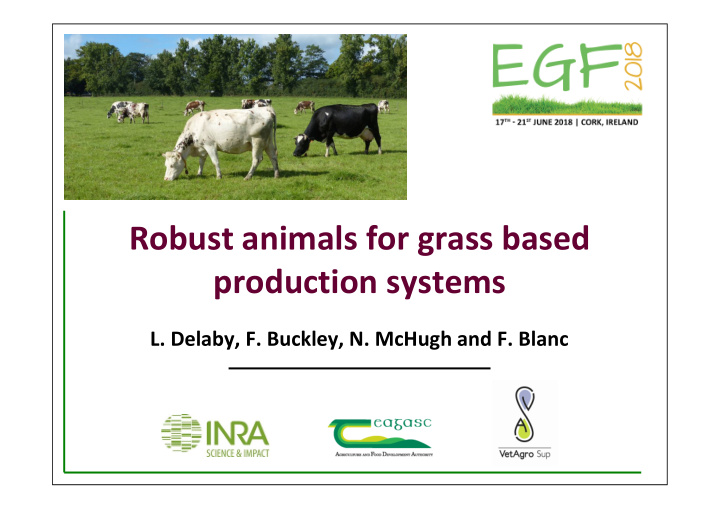



Robust animals for grass based production systems L. Delaby, F. Buckley, N. McHugh and F. Blanc
The message to take home … « A robust animal is transparent »
The message to take home … « A robust animal is transparent »
Grass-based production systems The ruminant’s natural ability to consume grass and forage is a chance and a challenge for the future Pasture-based systems are seasonal, less stable and more uncertain 100 Average 10 years 2008 2014 Good grazing management 90 Grass growth (kg DM/ha/day) imposes low 80 post grazing height 70 60 Herd demand 50 40 [2.5 cows /ha] 30 20 10 0 0 5 10 15 20 25 30 35 40 45 50 A robust animal should be able to face all the constraints associated with grass-based systems
1. The animal for the system Ability to adapt to grazing High level of intake in adverse conditions (balance per animal and per hectare performance) Large intake relative to their productivity potential Motivation : « agressive grazers » Ability to cope with resource variability and to rebound Easier to do if the nutrient demand is aligned with available resources � Capability to adapt milk or growth without negative effect on reproduction (body reserves) � Able to react (milk yield, fertility,…) when the feeding situation is improved
The key role of the breeding season J F M A M J J A S O N D Drought period risk Grazing season Dairy and beef cow - One calving season Calving Breeding Drying off Suckling ewe - One lambing season Mating Lambing Weaning Dairy and beef cow - Two calving seasons Drying off Calving Breeding …ding Calving Breed… Drying off To match herd & flock demand to the seasonality of grass availability
2. The animal for the system Re.calving / lambing Calving / Lambing Anoestrus Age at puberty / 1st Gestation calving or lambing age Abortion Commencement of luteal activity Assume all the cascade 1 st Ovulation of fertility to recalve/lamb Oestrus at the right period behaviour Gestation Fœtal Ovulation mortality Oestrus behaviour Ovulation Late embryo mortality Oestrus behaviour Non fertilisation / Gestation Ovulation Services Early embryo mortality Oestrus Ovulation behaviour Fertilisation
3. The animal for the system Ability for maternal care Deliver a viable offspring with minimal (no ?) human assistance Limit calf and lamb mortality with a high maternal behaviour Ability to stay healthy Cope with parasite burdens – High resistance (less impacts, less anthelmintic treatments) Metabolic disorders due to inclement weather and/or nutrients imbalance (tetany, toxemia, bloat) Feet and legs diseases (grazing is walking …)
Robustness is multi-functional traits 333 267 237 233 MS 150 d (kg) Relative In calf (%) 63 37 99 54 proportion Max BCS of average (%) - 1.1 - 0.6 - 0.6 - 1.2 loss (pts) 40 BCS calving 3.3 3.5 3.1 2.6 (pts) 20 0 -20 -40 Milk Solids Breeding BCS priority In difficulty priority priority MS in 150 days (average = 274 kg) BCS at calving (average = 3.1 pts) In-calf (average = 64%) BCS max loss in 150 days (average = - 0,9 pts) INRA – Le Pin-au-Haras / 2006 - 2013
To conclude … In high input indoor systems, the entire farm system serves the animal requirements In low input and grass based systems, the animal has to be adapted to the specific environmental context and challenges Better combine the genetic sub-indices available to select animal traits for grass-based systems Better understand the trade-off and more accurrently identify robust animals Develop research to define new traits of interest and imagine tools and methods to evaluate them
Thank you for your attention
Recommend
More recommend